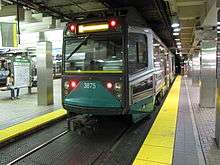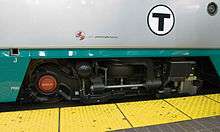MBTA accessibility
Physical accessibility on the Massachusetts Bay Transportation Authority (MBTA or "the T") system is incomplete but improving, with accessibility on all buses (including the Silver Line), all Orange Line stations, all but 2 Red Line stations, and all but 1 Blue Line station. As is true for most mass transit systems, much of the Boston subway and commuter rail lines were built before wheelchair access was a requirement. The Boston system underwent significant expansion in the 1980s and 1990s, and all the new facilities are ADA compliant. The MBTA has also refurbished many stations, and these too are accessible. More improvements are in progress or expected as part of planned construction.
In addition, on April 4, 2006, the MBTA announced the settlement of a class-action lawsuit, Joanne Daniels-Finegold, et al. v. MBTA, under which "the T will undertake major improvements in equipment, facilities and services that promise to enhance accessibility for people with disabilities while improving service for all T passengers. ...approximately $310 million in funds will be programmed into the T's Capital Investment Program to improve services and infrastructure."[1]
Accessibility on the T generally means that some combination of elevators and wheelchair ramps connect the street and station platform. The MBTA provides recorded elevator, wheelchair lift, and escalator status updates by telephone.
Subway


- All stations on the Orange Line, Blue Line, and the non-trolley branches of the Red Line have high level platforms on the same level as train car doors, and all are accessible except for Wollaston on the Red Line and Bowdoin on the Blue.
- Most subway stations and major surface stations on the light rail Green Line have been retrofitted with raised platforms for accessibility. These allow accessible boarding from the newer low-floor Type 8 cars, which have a built-in retractable bridge plate to reduce to gap to the platform. All trains should have at least one Type 8 car. Some stations have portable lifts or wooden wayside ramps to allow handicapped passengers to use the older high-floor cars; however, this boarding method is slower and only available at a limited number of stations.
- The Mattapan portion of the Red Line run runs older, high floor PCC trolley cars. Wheelchair ramps with hinged metal bridges have been installed at each station except for Valley Road, which has a long staircase from the platform to street level, which makes the platform itself inaccessible for wheelchair users.
Island platformed stations
Most MBTA subway stations have side platforms but a few have island platforms. The latter make it easier for wheelchair passengers to reverse direction, either because they missed a stop, or because the elevator on one side of a station is out of service. Some of these stations are not accessible to wheelchair users wishing to leave or enter them.
Island platformed Blue Line stations include:
- Bowdoin (no elevator access is now available to or from this platform, so wheelchair users can only use it to transfer between inbound and outbound trains)
- Government Center
- Maverick
Island platformed Green Line stations include:
- North Station (inbound track: in this case, the island platform is between the Green Line and Orange Line inbound tracks; elevators provide access to the outbound tracks of both lines)
- Haymarket
- Government Center
- Park Street (2 island platforms, one between the two southbound tracks and one between the two northbound tracks, the outer of which also has a side platform, connected to the island platform by an accessible grade crossing. Separate elevators are available from the Red Line island platform to the southbound and northbound Green Line elevators, after a project completed in 2012. Elevators connecting the Green Line platforms to an underground connecting passage provide a redundant route in case of an elevator outage.)
- Kenmore (2 island platforms, one between the two outbound tracks and one between the two inbound tracks)
- All Green Line Extension stations will have center island platforms, including the new Lechmere station
Island platformed Orange Line stations include:
- all stations between Oak Grove and Community College
- all stations between Back Bay and Forest Hills
Island platformed Red Line stations include:
- Alewife
- Davis
- Harvard (actually a hybrid island/side platform station, in which both platforms are on the west side of their respective tracks; platforms are connected by a sequence of two ramps that run downhill from the outbound platform to the lower turnstile area and thence to the inbound platform)
- Park Street (has both island and side platforms but only the island platform has elevator access; see description under Green Line above)
- Broadway
- JFK/UMass (there are separate islands for each branch of the Red line)
- Savin Hill (last center island on Ashmont branch)
- All stations between North Quincy and Braintree; however, Wollaston is currently not accessible. Since the July 2012 closure of the parking garage, Quincy Center is only partially handicapped accessible, with no wheelchair access from the Burgin Parkway entrance.
Commuter rail
As of November 2016, 106 out of 139 MBTA Commuter Rail stations (75%) are accessible.[2] Six lines are entirely accessible: the Greenbush Line, Plymouth/Kingston Line, Middleborough/Lakeville Line, Fairmount Line, Providence/Stoughton Line, and Needham Line, while the other lines have a mix of accessible and non-accessible stations. All stations built or rebuilt since about 1987 are accessible, many older stations have been retrofitted and several other stations are currently being rebuilt for accessibility.
With the exception of Chelsea and limited-service stops Prides Crossing and River Works, the Newburyport/Rockport Line is entirely accessible. Most of the non-accessible stations are located on the Fitchburg Line, Framingham/Worcester Line, and Franklin Line.
Of those stations that have wheelchair access, some only have a short elevated platform that serves one or two cars. These "mini-high platforms" are usually located at the end of the station away from Boston, allowing them to be served by the car nearest the locomotive. They represent most accessible stations on the Franklin Line, Needham Line, Framingham/Worcester Line, Fitchburg Line, Lowell Line, Haverhill Line, and Newburyport/Rockport Line, as well as several stations on the Providence/Stoughton Line and Fairmount Line. The limited-use stations at Foxboro (used for special events and game day service) and Buzzards Bay and Hyannis (used for the CapeFLYER service run with MBTA trains) have mini-high platforms as well.
Some commuter rail stations, mostly newer stations and those in larger cities, do have full-length high-level platforms that allow for accessible boarding on all cars. (The standard MBTA high-level side platform is 12 feet wide and 800 feet long, capable of fully handling a 9-car train – longer than any trainset currently in service. Some stations, including Forest Hills and Route 128, have Amtrak-style 1050-foot 12-car platforms.) The MBTA builds full-length high-level platforms at most new stations, and ultimately plans to build full-length high-level platforms at most stations except those requiring clearance for freight trains. Full-length platforms allow automatic power doors to be used, which allows passengers to board at all doors and thus speeding boarding times. High-level platforms are in place at all stations on the Greenbush Line, Plymouth/Kingston Line, and the Middleborough/Lakeville Line (all three of which have power doors in use), as well as all stations on the Fairmount Line except Fairmount and Readville. Other stations with full-length high-level platforms include:
- South Station
- Back Bay (all tracks except those serving the Framingham/Worcester Line, which only have a mini-high)
- Ruggles
- Forest Hills
- Route 128
- Providence
- T.F. Green Airport
- Wickford Junction
- North Station
- Littleton/Route 495
- South Acton
- Anderson RTC
- Lynn
- Salem
- Rowley
- Newburyport
- Yawkey
- Wachusett
Several other stations have high-level platforms that can accommodate several cars, but not necessarily all cars on a train. The Malden Center and Oak Grove platforms are shorter because they were built to be used as Orange Line platforms, as the line was to replace Haverhill Line service as far as Reading. Shorter rapid transit trains only require platforms around 400 feet long.
- Worcester
- Lawrence (built as full-length, but part of the platform edge was never installed due to track geometry)
- Lowell
- Malden Center
- Oak Grove (only used during Orange Line service disruptions)
The following stations are currently or planned to be rebuilt for accessibility:
- Chelsea (full-length high-level, planned)[3]
- Winchester Center (full-length high-level, planned)[4]
The following new stations are under construction (or in final design) with full-length high-level platforms:
- Boston Landing
- Blue Hill Avenue (planned)
- West Station (planned)
Buses
All bus service, including the Silver Line, is accessible.
The T also has a paratransit program, called The Ride, which provides lift-equipped vans to transport people who cannot use general public transportation because of a physical, cognitive, or mental disability, including those who use wheelchairs.
Blind and visually impaired

The MBTA states that "Service animals are always welcome on MBTA vehicles and in MBTA stations during all hours of service. The service animal should be kept out of the aisles as much as possible and under your control at all times." [5]
Some train stations have yellow detectable warning strips with truncated domes running in a two-foot (60 cm) band along the edge of the platforms. Most Red, Orange, and Blue Line stations have these tactile strips; however, many less-used Green Line surface stops and commuter rail stations lack them.
Buses and trains are supposed to have either recorded announcements or driver announcements of station stops, but these announcements are sometimes muffled, inaudible, or omitted by automated systems. In the event that automated systems are not functioning properly, the vehicle driver or conductor is to announce stops over the public address system.[6]
Hearing impaired
The MBTA has a TTY number for "T" information: (617) 222-5146. Many stations have TTY pay phones; the MBTA web site has a list.
The MBTA says it has reviewed its web site, http://www.mbta.com, using "the United States Section 508 guidelines and WCAG double AA guidelines, ... and made all required accommodations to help ensure that the site is accessible by users who rely on assistive technologies such as screen readers or other input mechanisms."
References
- ↑ 2006 MBTA press release on disability settlement Retrieved 2011 June 3
- ↑ "Ridership and Service Statistics" (PDF) (14 ed.). Massachusetts Bay Transportation Authority. 2014. Retrieved 9 February 2015.
- ↑ "Silver Line Gateway Extension of Silver Line Bus Rapid Transit (BRT) to Chelsea and East Boston: Public Informational Meeting, Chelsea, MA, August 18, 2014" (PDF). Massachusetts Department of Transportation Highway Division. 18 August 2014. Retrieved 2 August 2015.
- ↑ "Winchester Center Commuter Rail Station Repair Plans and Future Improvements". Massachusetts Bay Transportation Authority. Retrieved 25 July 2015.
- ↑ "General Accessibility Facts". Massachusetts Bay Transportation Authority. Retrieved 29 December 2012.
- ↑ "The Customer Experience and Accessibility Features on Heavy Rail Trains and at Heavy Rail Stations (Red, Orange, Blue Lines)". Massachusetts Bay Transportation Authority. Retrieved 29 December 2012.
If the train′s stop announcement equipment isn′t working, the train personnel are required to announce the destination of the train.